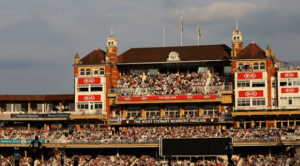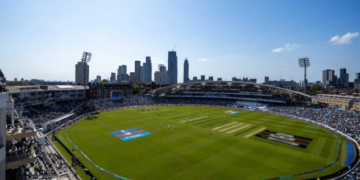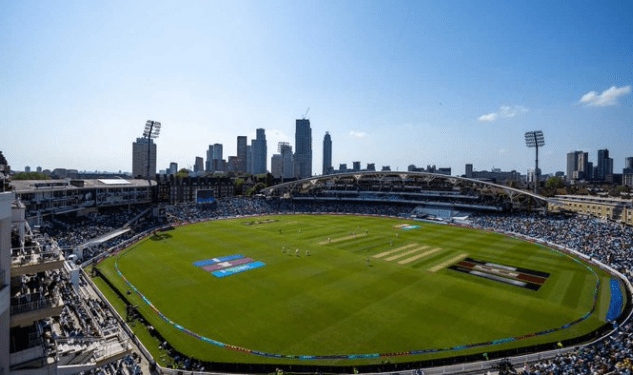Kennington Oval, the birthplace of cricket is one of the most iconic sporting grounds in the cricketing world. England’s first test match took place in the stadium in 1880 where the hosts beat Australia.
The ground has been renamed several times like the Brit Oval and The Kia Oval before landing on the name Kennington Oval. The Kia Oval has been the home ground for Surrey Cricket Club since 1845.
The stadium is the place where the famous Ashes tournament was born, two years after the inaugural Test in 1882. With a long history of cricket, the Kennington Oval hosted plenty of historic moments including Michael Holding’s 14 wickets in 1976, Don Bradman and Bill Ponsford’s 451 runs partnership stand in 1934.
The oval also hosted the FA Cup finals that took place between 1874 and 1892. The World Health Organisation (WHO) played a memorable gig in 1971. Over the years the stadium has undergone various upgrades in seating arrangements and general facilities for Players and spectators.
| Stadium | Kennington Oval Cricket Ground |
| Place, Country | London, England |
| Built | 1845 |
| Stand Names | JM Finn Stand, Peter May Stand, Lock Stand |
| Home Team | Surrey, Oval Invincibles |
| Seating Capacity | 23,500 |
Kennington Oval Pitch Report
The pitch of the Kennington Oval favors batters as revealed by the average scores being on the higher side. Fast bowlers might have some advantage in the initial stages of the match. teams chasing have won the majority of the matches at this venue across all formats.
Teams winning the toss will opt to bowl first at this venue and then chase down totals. At Kennington Oval, the teams chasing wins 55% of the time. The average men’s first innings score sits at 152 runs. With teams chasing success in 50% of matches. Interestingly, the same holds for the women’s Hundred where the average first innings score dips to 112 runs, yet teams chasing still win 50% of the time.
History of Kennington Oval
The first mention of the site is in a survey of 1615 when John Norden surveyed Kennington Manor and its properties. It was one of the five parts containing 38 acres and leased to Richard Salter.
In 1636, it was passed to Mrs. Marie Cox and in 1649 to George Cox. It was then known as the Forty Acres. From 1667, the land was used for horticultural purposes, with William Malcolm in 1758 required to provide one hundred Asparagus as part of his rent. In 1785, the land was divided into three tenements, and it was redivided in 1790.
William Otter bought the lease in 1826 and was granted a head lease of the property in 1835 for 99 years.
Otter’s purpose in buying the lease was to build a minister’s house, the first building project on the site, but due to a lack of agreement with the Prince Council of the Duchy, the plan never materialized.
He converted the nursery into a market garden and petitioned for a building lease to build houses. After his death, the Otter Trustees continued to try and find ways to use the land, as opposition and disagreements over building plans kept arising, with the last one in 1851 being dropped due to Prince Albert’s interference.
In 1845, it was reported that William Houghton, the president of the Montpelier Club was interested in converting the land into ‘Cricket Grounds’. In May 1845, the first match was played. After playing several times, Surrey club has increasingly played at The Oval, later becoming the sole tenant in 1874, after acquiring Houghto’s lease in 1855.
The lease given to Surrey Club outlined the purpose which the grounds were being used for stipulating that no games shall be played other than cricket baseball, Football, Tennis, Fives, Racquets, and Athletics’.
During the Second World War, the Oval suffered from bombing and was intended for use as a prisoner-of-war camp, and the stadium was resumed as Cricket Grounds in 1946.
The Pavilion
A Pavilion was built for the Oval in 1858, before being replaced by the current pavilion, designed by Thomas Muirhead in 1895-97. It has been restored in 2013 with a new front gate being installed.
The new pavilion Portico at The Oval Cricket Ground has transformed the entrance and forecourt area, previously occupied by turnstiles and concessions.

The Hoobs gate designed by Louis de Siossons has been placed with a new portico. The portico features column capitals modeled upon the Prince of Wales to indicate Surrey Cricket Club.
The gate piers’ design is based on the design that holds the ashes of the bails that were burned at the end of the fateful 1882 match. Further models of this urn appear on the railing on either side and top of the main entrance.
The Gasometer
The Victorian Gasometer is located next to The Oval was built in 1847. The iron structure was the largest gasholder in the world when it was built and the building is now grade 2 category.
Timber Windows near The Oval
Kennington has a variety of styles of timber sash windows, including Victorian sash bay windows, six over-box sash windows, and curved sash windows. At the sash window workshop, we have over 20 years of experience repairing and replacing timber windows and doors across London and the South.
Best Stand to Sit at The Kia Oval
With various stands available in The Kia Oval, The Greenroom is more suitable and looks more lavish than the seats in The Montpelier Club, Duchy Site, Executive Boxes, Corinthian Roof Terrace, Ashes Suite, and The Lock Balcony.
Located behind the bowler’s arm with Padded seats, The Green Room gives direct access from the England Suite. The Green Room also features stunning views of the Kia’s Pavilion. When it comes to The Kia Oval, it doesn’t get much better than the Green Room.
The Montpelier Club consists of padded armchair seating next to the player’s Dressing room. The historic Pavilion features some of the best seats in the house.
The Duche Suite seats are located in the new Galadari Stand directly outside the Duchy Suite with great views of the action and JM Finn Stand.
The Executive Boxes give Private Balcony seating on a premium level of the stadium, with fantastic views of the pitch and the JM Finn Stand.
The Corinthian Roof Terrace located on the top floor of the JM Finn Stand, features views behind the bowler’s arm and Panoramic views of the magnificent City of London.
The Ashes Suite provides a great view of the action and pavilion, Ashes Suite seats are located in the lower tier of the JM Finn Stand.
The Lock Balcony has elevated seats in the new Galadari stand has a relaxed and informal with open views across the stadium.
Kennington Oval Stats
| Competitions | ODI | T20 | Hundred |
| Matches Played | 73 | 168 | 20 |
| Runs | 16991 | 4255 | 5417 |
| Highest Score | 398 | 254 | 201 |
| Lowest Score | 80 | 81 | 7 |
| Average | 485.5 | 303.9 | 270.9 |
| Balls Faced | 18333 | 3120 | 3782 |
| Strike Rate | 92.6 | 136.3 | 143.2 |
| 4s | 1555 | 393 | 424 |
| 6s | 243 | 108 | 247 |
| Won | 16 | 8 | 7 |
| Loss | 18 | 6 | 12 |
FAQ’s
Where is the Kennington Oval?
The Kennington Oval is located in London, England.
What are the general weather conditions at Kennington Oval?
The Weather is usually mild in London, but it can have different types of conditions, with sometimes rain coming from the clouds.
What is the boundary size of the Kennington Oval?
The boundary size of the Kennington Oval, Onside: 67M, Off-side: 70M, Vauxhall End: 68M, Pavilion End: 66M.
How to Purchase Tickets at Kia Oval?
The tickets for all fixtures can be purchased by calling the Ticket Office at 02039460100 or the tickets can be purchased through an online portal.
Also Check: Ex-England Cricketer Graham Thorpe Passes Away at 55
























